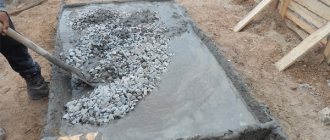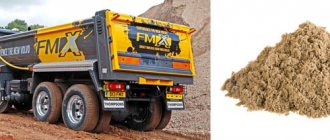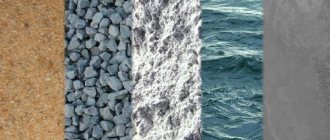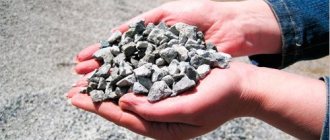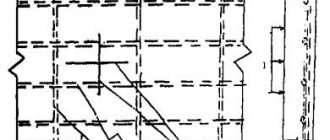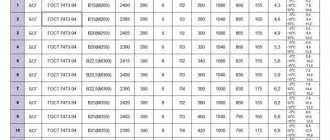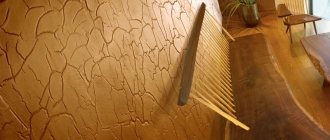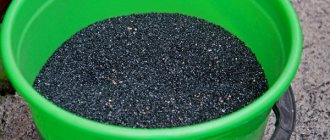Question. Hello! I heard that cement in bags should be used as quickly as possible and, if possible, not left for long-term storage. Therefore, I want to buy the most accurate number of bags of cement for concreting the foundation. How many bags of cement are needed per cube of concrete? I will buy 50 or 40 kg bags.
Answer. Good afternoon Yes, indeed, it is best to use cement immediately after purchase, because during storage, even if the bags are wrapped in polyethylene, it still quickly loses its properties.
In private housing construction, heavy concrete based on Portland cement, crushed stone, sand and water is usually used. Considering that the most popular and most affordable brands of Portland cement are CEM I 32.5N PC and CEM I 42.5N PC (old designation M400 and M500), we will summarize the required amount of cement of these brands for the preparation of 1 meter of cubic concrete of popular brands in the following tables.
For cement TsEM I 32.5N PC (M400)
| Concrete grade | Cement CEM I 32.5N PC (M400) | ||
| Weight of cement, kg | bag 50 kg, pieces | bag 40 kg, pieces | |
| M100 | 175 | 3,5 | 4,4 |
| M150 | 215 | 4,3 | 5,4 |
| M200 | 255 | 5,1 | 6,4 |
| M250 | 295 | 5,9 | 7,4 |
| M300 | 335 | 6,7 | 8,4 |
| M350 | 380 | 7,6 | 9,5 |
| M400 | 420 | 8,4 | 10,5 |
For cement TsEM I 42.5N PC (M500)
| Concrete grade | Cement CEM I 42.5N PC (M500) | ||
| Weight of cement, kg | bag 50 kg, pieces | bag 40 kg, pieces | |
| M100 | 160 | 3,2 | 4,0 |
| M150 | 190 | 3,8 | 4,8 |
| M200 | 225 | 4,5 | 5,6 |
| M250 | 255 | 5,1 | 6,4 |
| M300 | 290 | 5,8 | 7,3 |
| M350 | 325 | 6,5 | 8,1 |
| M400 | 355 | 7,1 | 8,9 |
As can be seen from the table, it is almost impossible to select a whole number of bags of cement to prepare 1 m3 of concrete. Therefore, in order not to degrade the quality of the building material with a reduced amount of binder, the number of bags should be rounded up, and the remaining cement should be carefully packed in plastic bags, for example, in popular plastic garbage bags. In this form, cement can be stored in dry rooms on a wooden stand in within 6 months.
Alternatively, you can combine the purchase of 50 or 40 kg bags with lighter weight 20 or 25 kg bags of cement.
For example. To prepare 1 m3 of concrete grade M350, 380 kg of cement Cement CEM I 32.5N PC is required. Accordingly, you can purchase 6 bags weighing 50 kg (50x6 = 300 kg) and two bags weighing 40 kg (40x2 = 80 kg).
Another example. To prepare 1 m3 of concrete of the most popular brand M200, 225 kg of cement Cement CEM I 42.5N PC is needed. Accordingly, the best option is to purchase 4 bags of cement weighing 50 kg (4x50 = 200 kg) and one bag weighing 25 kg.
House construction is based on clear calculations, incl. for concreting. The construction of almost all buildings requires the preparation of a working solution (mixture). It is used in the implementation of concrete screeds, paths, and foundations. Therefore, it is necessary to take into account how much material is used for 1 cubic meter of concrete.
Basis of calculations
To understand the number of components, you should determine the composition and proportions of the mixture. Cement is the main connecting link in the solution , which forces all other components to interact - gravel, crushed stone, sand. Depending on the purpose of the material, the required grade strength is selected.
To avoid injury when working with cement, it is necessary to use safety glasses, gloves and a respirator. This will prevent the penetration of cement dust into the mucous membranes
How many cubes of crushed stone in a cube of concrete
Concrete consists of several components - water and plasticizers. The fillers used are gravel or crushed granite stone, sand or pgs, fine and. The mixture is classified by grade, for the production of which certain proportions of all components are taken. For example, one M100 cube will require 200 kg of cement. In order not to count how much crushed stone you need manually, there are special tables with proportions for the popular product.
If there are no such tables at hand, to calculate the amount of crushed stone, proceed from the average consumption. To make one cubic meter of the mixture, take 0.7 m3 of crushed stone. A cube of granite weighs about 1400 kg. This means you need to take at least 1 ton of crushed stone.
To prepare the solution, you can use a simplified scheme:
for one part of cement – 0.5 parts water, 4 parts crushed stone, 2 parts sand.
With this ratio, for one cube of solution you will approximately need:
- 330 kg of cement mixture;
- 180 liters of water;
- 600 kg of sand;
- 1250 kg of gravel.
This method is used when factory accuracy of brand compliance is not required.
How much cement is needed for 1 cubic meter of concrete?
The quantity required to prepare the concrete mixture is indicated in the tabular data.
| Consumption per 1 cubic meter | ||
| Concrete, M | Cement, l | The same, kg |
| 100 | 111.00 | 166.00 |
| 150 | 137.00 | 205.00 |
| 200 | 161.00 | 241.00 |
| 250 | 200.00 | 300.00 |
| 300 | 213.00 | 319.00 |
| 400 | 278.00 | 417.00 |
| 450 | 313.00 | 469.00 |
Similar ratios are relevant for a material with a density of 1500 kg/m³. This is a medium loose material.
Amount of cement for 1 m3 of concrete
To facilitate independent calculations, it is recommended to buy cement in 50 kg bags, since all ratios are given taking into account their use. In addition, you can use them as a kind of meter.
For example, to get a high-quality concrete mortar of grade 300, you will need to mix one bag of 400-grade cement, 5 bags of gravel and 3 bags of sand.
In order to know how much cement is needed per 1 cubic meter of concrete for the foundation, you can be guided by the following data.
| M 500 | 501 |
| M 450 | 468 |
| M 400 | 418 |
| M 300 | 318 |
| M 250 | 301 |
| M 200 | 242 |
| M 150 | 206 |
| M 100 | 167 |
The proportions of concrete are given with the condition that cement is used in bags weighing at least 50 kg.
When purchasing, pay attention to the production time of the cement.
When buying cement, it is recommended to pay attention to the period of its manufacture, since if storage rules are not followed, it may lose its properties.
Therefore, the more it is in the store or in your garage, the more it will be needed to achieve a good result.
When using a material made six months ago, it can lose a quarter of its properties and turn from M400 to M100.
Proportions per 1m³, table
The composition and proportional ratio of the components of the concrete mixture based on the grade strength of the material are indicated below.
| Cement M400 | |||
| Concrete, M | Proportional ratio C/P/Shch, kg | Volume ratio of sand and crushed stone per 10 liters of Portland cement, l | Volume of solution produced from 10 liters of cement, l |
| ̴100 | 1.00/4.60/7.00 | 41.00/61.00 | 78.00 |
| 150 | 1.00/3.50/5.70 | 32.00/50.00 | 64.00 |
| 200 | 1.00/2.80/4.80 | 25.00/42.00 | 54.00 |
| 250 | 1.00/2.10/3.90 | 19.00/34.00 | 43.00 |
| 300 | 1.00/1.90/3.70 | 17.00/32.00 | 41.00 |
| 400 | 1.00/1.20/2.70 | 11.00/24.00 | 31.00 |
| 450 | 1.00/1.10/2.50 | 10.00/22.00 | 29.00 |
| Cement M500 | |||
| ̴100 | 1.00/5.80/8.10 | 53.00/71.00 | 90.00 |
| 150 | 1.00/4.50/6.60 | 40.00/58.00 | 73.00 |
| 200 | 1.00/3.50/5.60 | 32.00/49.00 | 62.00 |
| 250 | 1.00/2.60/4.50 | 24.00/39.00 | 50.00 |
| 300 | 1.00/2.40/4.30 | 22.00/37.00 | 47.00 |
| 400 | 1.00/1.60/3.20 | 14.00/28.00 | 36.00 |
| 450 | 1.00/1.40/2.90 | 12.00/25.00 | 32.00 |
Considering that the specific gravity of finished reinforced concrete is, on average, 2200 kg/m³ , it is possible to calculate which ratio is correct for the required grade. Such calculations allow you to understand how many components of the solution and the amount of other components.
When moving bags of cement independently, the load is lifted with slightly bent knees without loading the back muscles
How much crushed stone is in KAMAZ
To deliver bulk materials, vehicles of various carrying capacities are used. To calculate the amount that will go into a KAMAZ, you need to divide the load capacity by the density of crushed stone specified in the manufacturer’s specifications. For example, with a density of 1300 kg/m3, it will fit into the car:
- 7.7 t – 5.9 cubic meters (7700:1300);
- 15 tons – 11.5;
- 25 t – 19.
In addition, the volume of the body is taken into account, which will show the maximum permissible load. It is usually less than the obtained figure. The higher the bulk density of the material, the less it will fit into the machine.
Thus, when choosing, take into account the load capacity of the dump truck, the density of crushed stone, its humidity (since weight depends on this), and the fraction that affects the bulk density.
If the crushed stone has already been brought to the construction site, you can check its weight. To do this, before unloading, you need to measure the height, width, length of the car body and multiply the values. This is how we find out the volume of cargo in cubic meters. Taking into account the fact that a couple of cubes still fit on the sides, they can be added to the result. The value found will show whether the weight corresponds to what was declared and paid for.
But how much of each component should you take to make the mixture good and uniform? Typically, concrete volume indicators are expressed in cubic meters. And therefore, specialists definitely need to know exactly how much cement, sand and crushed stone is in 1 m3 of concrete.
The type of concrete mixture influences the amount of materials used. The strength and technical characteristics of the resulting concrete will depend on what proportions and ratios were used.
For example, when creating 1 cubic meter of M 300, which is the most popular, you need to take 382 kilograms of M 400 grade cement, 705 kilograms of coarse sand, 1080 kilograms of crushed stone and 220 liters of water.
How many bags of cement in a cube of mortar
It is recommended to purchase building material in bags weighing 50.00 kg. This will simplify the calculation part.
The material is consumed as follows:
- M450 – 469.00 kg – 9 bags and 19 kg;
- M400 – 417.00 kg – 8 bags and 17 kg;
- M300 – 319.00 kg – 6 bags and 19 kg;
- M250 – 300.00 kg – 6 bags;
- M200 – 241.00 kg – 5 bags without 9 kg;
- M150 – 205.00 kg – 4 pieces and 5 kg;
- M100 – 166.00 kg – 3 pieces and 16 kg.
In order to reliably determine the question of how many bags will be needed, it is necessary to decide what the grade strength of the finished reinforced concrete should be.
Calculation per 1 cubic meter
Additional data must be taken into account before resolving the issue.
The following factors are important:
- if the working solution contains a small volume of cement, it will be mobile. When constructing critical structures, mistakes are unacceptable;
- the use of a mixture with reinforcement laying helps to increase cement consumption;
- the total amount of water is determined empirically directly at the construction site; it depends on the moisture content of the sand;
- The quality of the binder component depends on the shelf life. If the material is stored for a long time, it loses its declared characteristics. After six months, the initial indicators decrease by about a third. It is advisable to purchase the material before starting construction work.
Composition of 1 cube of concrete
The preparation of a working solution based on brand strength, filler size and water-cement number is presented in the table.
| Concrete, M | Cement M | Ratio of water and cement, VC | Filler fraction, mm | Volume of water, l per m³ of concrete | Weight of cement, kg per m³ of concrete | Weight of sand, kg per m³ of concrete | Weight of crushed stone or gravel kg per m³ of concrete |
| ̴100 | ̴300 | 0.750 | 10.0 mm gravel | 205.00 | 273.00 | 1092.0 | 1092.0 |
| 0.80 | 10.0 mm crushed stone | 220.0 | 275.0 | 1100.0 | 1100.0 | ||
| 0.750 | 20.0 mm gravel | 190.0 | 253.0 | 1012.0 | 1012.0 | ||
| 0.80 | 20.0 mm crushed stone | 205.0 | 256.0 | 1024.0 | 1024.0 | ||
| 200 | 400 | 0.630 | 10 mm gravel | 205.00 | 325.0 | 1300.0 | 1300.0 |
| 0.680 | 10 mm crushed stone | 220.0 | 324.0 | 1296.0 | 1296.0 | ||
| 0.630 | 20.0 mm gravel | 190.0 | 302.0 | 1208.0 | 1208.0 | ||
| 0.680 | 20.0 mm crushed stone | 205.0 | 302.0 | 1208.0 | 1208.0 | ||
| 250 | 500 | 0.640 | 10.00 mm gravel | 205.0 | 320.0 | 1280.0 | 1280.0 |
| 0.690 | 10.00 mm crushed stone | 220.0 | 319.0 | 1276.0 | 1276.0 | ||
| 0.640 | 20.00 mm gravel | 190.0 | 297.0 | 1188.0 | 1188.0 | ||
| 0.69 | 20.00 mm crushed stone | 205.0 | 297.0 | 1188.0 | 1188.0 |
All components are connected in accordance with the selected proportion. The table shows how many kg of cement are in m³ of concrete.
Pricing depends on the season of work, which should be taken into account during the preparatory stage of construction
How many kg of crushed stone per cube
According to the origin of crushed stone, there are, and. All components are different:
Granite is the leader in strength and density - up to 2600 kg/m3. The bulk volume of gravel and granite is almost the same - up to 1300-1400 kg/m3. Limestone has the lowest rates.
All characteristics are indicated by the manufacturer. Knowing them, you can calculate how much crushed stone is in 1m3. To do this you need:
density x fullness x water absorption coefficient.
For example, a cube of granite crushed stone with a density of 2600 kg/m3, fraction 5-20 mm, fullness 57%, moisture absorption 1.1, weighs 1347 kg.
The table will help you figure it out:
How much cement is needed for 1 cube of concrete - important aspects
Preparing a high-quality mixture requires taking into account the following parameters:
- activity, weight, beginning and end of setting - for cement;
- parameters of volumetric mass, mobility, water separation, density, water resistance - for reinforced concrete mixture;
- voidness, grain size, volume, weight, humidity, concentration of organic and clay substances - for sand;
- weight, strength, voidness, presence of foreign inclusions and impurities, concentration of needle-shaped and lamellar grains - for crushed stone.
Let's sum it up
Based on the data above, the following can be understood::
- how much cement is in a cube of concrete M200 – 241.00 kg;
- concrete M300 – 319.00 kg;
- concrete M400 – 417.00 kg;
- concrete M500 – 450.00 kg.
The main task of a private developer is to correctly calculate the amount of material required to implement the assigned construction tasks. This will help reduce work costs.
One of the practical ways of mixing concrete is shown in the video:
Books on the topic:
Cement is the basis of the concrete mixture; it is what binds the other components together. It has a direct impact on other indicators: strength, frost and moisture resistance, dosage deviation leads to their inevitable change. Another feature is the price: of all the ingredients, the binder is the most expensive; it is economically unprofitable to add more of it when mixing, as well as to purchase it in advance (the loss of useful properties begins 2 months after release). As a result, it is extremely important to know how much cement is needed per cubic meter of concrete before starting work, and during the preparation process - to fill it within normal limits according to the selected type and brand of mortar.
Factors influencing binder proportions
The main condition is the achievement of strength properties, which, in turn, depend on the intended purpose of the building structure. The proportions are selected taking into account the expected class of concrete (the recommended dosage is given in the table below), its mobility, frost resistance and water resistance. In addition to the basic regulatory requirements, the final performance of the concrete solution is affected by:
- Strength grade, activity, bulk density and setting time of cement.
- Condition of the sand: grain size, humidity, presence of impurities. If the proportion of sludge exceeds 15%, careful sieving, washing and drying is required; this factor is easily checked by pouring water.
- Parameters of crushed stone or other coarse filler: flakiness, fraction size, specific gravity, degree of contamination. By analogy with sand, it must be washed and dried.
- Contains plasticizers or hardeners.
The approximate consumption of cement per 1 cubic meter of concrete is given in the table:
| Expected strength grade | How much cement is needed for 1 m3, kg | Amount of cement in liters |
| M100 | 166 | 111 |
| M150 | 205 | 137 |
| M200 | 241 | 161 |
| M250 | 300 | 200 |
| M300 | 319 | 213 |
| M400 | 417 | 278 |
| M450 | 469 | 313 |
Concrete components
By type of concrete binders
divided into silicate, cement, gypsum, polymer concrete and others
The greatest preference is given to concrete made on a cement base, using granite crushed stone and sand as fillers.
Crushed stone or gravel
is the product that is obtained by crushing rocks in a quarry. In its production, it is possible to use gravel or boulders, but it is mainly obtained from granite.
Granite
is the hardest and densest rock, consisting of crystals of mica, quartz and feldspar. This composition is also reflected in the color of crushed granite stone. Standard fractions of this material are usually 20-40 mm, 5-20 mm and 40-70 mm.
Granite gravel
produced by crushing rocks into small fractions. The quality of this material depends on the grain composition, water absorption, strength and radioactivity. It is more resistant to temperature changes and stronger than limestone. It is made from loose sedimentary rocks and has a round grain shape, ranging in size from 3 to 10 mm.
In turn, lime gravel
consists of calcite. This type of crushed stone is made from sedimentary rocks. It has an angular shape of fractions and is an environmentally friendly building material.
Any type of gravel is a granular bulk material. It is used in various fields of construction: concrete filling, road construction, landscaping, cladding and artistic decoration. The price for it depends on its type. When buying gravel, it is recommended to ask the seller for a hygiene certificate.
One cube of concrete
The unit of calculation when purchasing gravel is called a cubic meter or cubic meter. Basically, one cube contains a large amount of crushed stone weighing 1.4 tons (
depending on the type of material). For example, limestone is lighter than granite.
In the production of concrete, water, cement and various types of aggregates, sand and gravel mixtures (SGP), which are small (such as sand) and large (such as gravel), are used. Builders often have a question about how to properly mix the concrete mixture; it is at this stage that it is usually necessary to decide how much cement is contained in 1 cubic meter of concrete and how much cement is needed.
Today, there are a huge number of grades of concrete that differ in their composition, namely, in the mass or volume ratio of the PGS components contained in it. For example, in order to create one cubic meter of concrete grade 100, 200 kg of cement will be required
, and to create 1 cubic meter of concrete grade 400, 360 kg of cement will be required.
There are various special tables from which you can understand not only how much cement powder is required for 1 cubic meter of concrete, but also the percentage of other components in the finished solution.
For example, for the most popular concrete grade 300, you will need to mix 382 kg of M400 cement powder, 705 kg of sand, 1080 kg of gravel and 220 liters of water.
For grade 100 you will need 214 kg of M400 cement, 1080 kg of gravel, 870 kg of sand and 210 liters of water.
Using the following scheme, in general terms you can calculate how much sand is contained in 1 cube of concrete
: For a concrete mixture of grade 100, per 1 volume fraction of cement powder there are 4 parts of sand and 6 parts of crushed stone; For grade 150, the ratio is M400 grade cement powder, 3.2 parts of sand and 5 parts of gravel;
Knowing these proportions, you can easily determine, for example, how much crushed stone is contained in one cube of concrete and mix any required amount of high-quality concrete.
It should be noted that its mechanical and physical properties will depend on the brand of cement used in the production of concrete. For example, if you add cement powder M500 instead of M400, the grade of concrete will increase (instead of 200 it will be 350)
. First of all, to obtain a good mixture, you need to select crushed stone with a grade that is 2 times higher than the grade of concrete you want to obtain.
A simple scheme for mixing concrete
If construction does not require factory precision and there is no need to strictly maintain the grade, you can use a simplified scheme: for 1 part of cement powder, take 0.5 parts of water, 4 parts of gravel and 2 parts of sand. In order to produce 1 cubic meter of concrete mixture, with a given ratio, the weight fractions of the components will be as follows: 330 kg of cement powder (0.25 cubic meters), 180 liters of water (0.18 cubic meters), 600 kg of sand (0.43 m cubic), 1.25 tons of gravel (0.9 m cubic).
Proportions of sand, crushed stone, cement to obtain 1 cube of concrete
M50
380 kg. Portland cement M400 (1) 645 kg. sand (1.69) 608 kg. gravel (1.59) 210 l. water (0.55)
M75
175 kg. Portland cement M300 (1) 945 kg. sand (5.4) 1053 kg. gravel (6.02) 210 l. water (1,2)
M100
214 kg. Portland cement M300 (1) 870 kg. sand (4.07) 1080 kg. gravel (5.05) 210 l. water (0.98)
M150
235 kg. Portland cement M400 (1) 855 kg. sand (3.64) 1080 kg. crushed stone (4.6) 210 l. water (0.89)
M200
286 kg. Portland cement M400 (1) 795 kg. sand (2.78) 1080 kg. crushed stone (3.78) 210 l. water (0.74)
M250
332 kg. Portland cement M400 (1) 750 kg. sand (2.26) 1080 kg. crushed stone (3.25) 215 l. water (0.65)
M300
382 kg. Portland cement M400 (1) 705 kg. sand (1.85) 1080 kg. crushed stone (2.83) 220 l. water (0.58)
M350
428 kg. Portland cement M400 (1) 660 kg. sand (1.54) 1080 kg. crushed stone (2.5) 220 l. water (0.51)
The sequence of placing materials into a concrete mixer affects the quality of concrete.
Crushed stone is a product of crushing rocks of varying densities. Belongs to the category of bulk materials. To calculate the number of kilograms in one cubic meter, you need to take into account its type and technical characteristics.
Recommended proportions when mixing concrete
If the requirements for the quality of the solution are not strict, a simple and time-tested ratio is chosen: 1: 2: 4: 0.5 (cement, sand, crushed stone, water, respectively). In terms of weight, this amounts to 330 kg of binder, 600 kg of sand, 1250 kg of coarse filler and 180 liters of mixing liquid. In other cases, the proportions are selected and converted to weight calculation (recognized as more convenient) according to the data in the table (provided that Portland cement is used with a quality not lower than M400):
| Expected concrete strength grade | Component share | |||
| cement | crushed stone | sand | water | |
| When using Portland cement M400 | ||||
| M100 | 1 | 4,6 | 7 | 0,5 |
| M150 | 3,5 | 5,7 | ||
| M200 | 2,8 | 4,8 | ||
| M250 | 2,1 | 3,9 | ||
| M300 | 1,9 | 3,7 | ||
| M350 | 1,5 | 3,1 | ||
| M400 | 1,2 | 2,7 | ||
| M450 | 1,1 | 2,5 | ||
| M500 | 1 | 2 | ||
| The same when using Portland cement M500 | ||||
| M100 | 1 | 5,8 | 8,1 | 0,5 |
| M150 | 4,5 | 6,6 | ||
| M200 | 3,5 | 5,6 | ||
| M250 | 2,6 | 4,5 | ||
| M300 | 2,4 | 4,3 | ||
| M350 | 1,9 | 3,8 | ||
| M400 | 1,6 | 3.2 | ||
| M450 | 1,4 | 2,9 | ||
| M500 | 1,2 | 2,5 | ||
Thus, to determine how much cement is required for concreting, the type is first established and the volume of the structure is calculated, and based on these data, all other components are calculated. The minimum acceptable grade of mortar for foundations and load-bearing walls is M200; as the number of storeys and other loads increase, the requirements increase.
Read about how to calculate the amount of cement for the construction of various structures
here
.
Preparation of the solution
The quality and uniformity of the concrete mixture depend not only on the selected proportions and degree of preparation of the ingredients, but also on their sequence of joining. In private construction, two methods of preparing mortars independently are practiced: manual and mechanized using a concrete mixer. In the first case, the binder and filler are first thoroughly mixed in a dry state (starting with cement and sand) and only then mixed with clean water. All components must be prepared in advance, taking into account the required volumes.
For mechanized mixing, a completely different sequence is recommended. First, about 80% of the total share of water is poured into the bowl of the concrete mixer, after which sand and cement are added in small portions, with periodic rotation of the drum or blades, and finally coarse filler. The remaining dose of liquid is poured in small doses; excess has a negative effect on the strength of concrete.
In general, when preparing a solution, the following rules must be taken into account:
1. When laying a reinforcement frame (concreting foundations, load-bearing walls and ceilings), an increased proportion of cement is introduced into the composition - from 220 kg per cubic meter, this is the minimum norm for reinforced concrete products.
2. The declared strength of cement deteriorates during long-term storage; it is impossible to use a binder produced more than six months ago for mixing with the same proportions.
3. The final class of concrete depends on the quality of the filler: sand, crushed stone or gravel. Increasing the proportion of cement has a positive effect on strength, but only up to a certain limit: when adding more than 400 kg of cement per cubic meter of solution, it will remain unchanged, and when filling over 500, it will begin to fall.
4. When preparing concrete mixtures for the foundation, crushed stone or gravel with a compressive strength of at least 800 kg/cm2 is used.
5. The total volume of individual components is always higher than that of the resulting solution; this must be taken into account when calculating materials.
6. Before purchasing cement, you should check not only the date of manufacture and the availability of a certificate, but also check its bulk density; the recommended minimum is 1300 kg/m3.
7. To speed up the process, you need to select a working container for backfilling (most often a bucket) and calculate how much sand and crushed stone weighs when it is completely filled and compacted.
8. An amendment (reducing the W/C ratio) when the filler is over-moistened is required.
9. The values indicated in the table above are relevant when using exclusively fresh cement with a strength grade of at least M400. Preparation of concrete mixtures based on a binder of inferior quality increases its share several times.
10. There is a way to recalculate the proportions if it is necessary to use inferior cement. The coefficients of transition to the next brand are at least 0.9; it is by this value that the proportion of binder in the concrete mixture must be increased.
11. It is impossible to obtain high-class concrete based on cement with a lower strength grade.
12. When mixing the mortar for pouring a monolithic foundation, adding crushed stone to the composition is mandatory. Its optimal ratio with sand in volumetric terms reaches 0.8:0.5.
13. The permissible deviation when selecting the dosage per cubic meter for cement does not exceed 1 kg, for crushed stone – 5.
Every person who has started construction work, be it building a building or making a site, is faced with the process of preparing concrete. Concrete is a cement-pitch mortar filled with crushed stone or expanded clay. Its quality and strength depend on the correctly specified proportions of concrete components. If the components of concrete are set incorrectly, it will not last long and will collapse from atmospheric influences literally within a season.
How much concrete will be produced from 50 kg of cement?
In order to determine how many cubic meters of concrete will be obtained from 1 50 kg bag of cement, you need to calculate how many kilograms are in 1 m3. If there is not enough binder component, then the work will not be completed, and if there is excess left, then during long-term storage it will lose its properties. In both cases, incorrect calculation of cement consumption per cubic meter of concrete will lead to unnecessary waste of money.
What determines the volume of concrete produced from cement?
Cement mortar is a mixture that contains the following components:
It is mixed in different proportions, it all depends on the purpose. To fill the floor you will need several bags: one of cement and three of sand. In general, the ratio of materials should be: 1 – 3 – 0.5, where the latter is part of the water. Based on a bag of dry material equal to 50 kg, the proportions are: 50 – 150 – 25 (kg-kg-l). These figures are relative, and in practice depend on the brand of solution and the chemical composition of the sand. It is important to consider the use of plasticizers, which affect the proportions of materials.
Parameters that are taken into account when performing calculations:
1. Brand of concrete – selected depending on the purpose of the construction work;
2. Packaging of cement and its class.
The binding element is packaged in bags from 5 to 50 kg.
Calculation of mass based on the nominal volume of the bag
In order to correctly determine how many cubic meters of concrete will be produced from one package weighing 50 kg, you should calculate the number of kilograms in 1 m3. You need to know the dry density of the mixture. For cement, this parameter = 1.3 t/m3. The volume of the container (in this case, the bag) is equal to the product of density and weight.
For concrete, this parameter directly depends on the fillers included in its composition. There are several types:
Lightweight, filled with air;
Heavy, with the addition of crushed stone, gravel and limestone;
Particularly heavy, with barite and hematite.
In order to find out how much M500 grade concrete can be prepared from a bag of cement (in cubic meters), certain proportions must be observed. Professional builders advise using a ratio of 1-2-3, cement - sand - crushed stone, respectively. The final result for concrete is equal to 300 kg. Portland cement is best suited for various types of construction work.
Basic counting rules
The less cement there is in the solution, the better mobility the concrete will have. That is, in order to mix the mixture, the error in calculating the hardener should be no more than one kg, and the error of crushed stone should be no more than 5 kg. If you add a small proportion of hardener, the solution will not support the weight of crushed stone and its binding elements. Under any adverse weather conditions: wind, rain, severe frost or high temperatures, it will become unusable in just one season. This is not scary if the plans include decorative paths, but if a wall is being built, then you should play it safe and add an extra kilogram.
To carry out competent calculations, it is important to take into account the brand of cement. It should be 0.5 times higher than that of concrete. When choosing the latter class, you should focus on the purpose of the construction work. If you are planning actions with the foundation, then it is better to use M-200, if laying out surfaces - M-300. Concrete grade M-500: the hardener has high strength, ideal for hydraulic engineering. M-400 sets quickly, is durable, and is suitable for the construction of structures with high safety requirements. The number of concrete grades is equal to the number of types of places of use. Possible options:
• Monolithic ceilings;
It is important to decide on the class of concrete before starting calculations.
The solution is mixed as 1 to 3 and to 5 (cement, sand, crushed stone), for a total of nine parts. All components during work must be measured with these parameters. For 1 kg of M400 cement, sand = 2 kg is required, that is, the proportion is 1:2; for M500 – 1:3. The recommended ratio of concrete (meter per cube) is 0.8 m3 of filler and 0.5 sand. You cannot lay more than 360 kg of cement per 1 cubic meter. If the package weight = 50 kg, you should use no more than seven bags, otherwise cracks may appear.
The optimal meter is a bag
To make it easier to calculate how much concrete will be produced from a certain amount of cement, you should buy the material in bags weighing 50 kg. If made from M400 cement, you will need 417 kg - 6 bags + 17 kg, and for M500 - 9 + 19 kg.
This kind of capacity as a meter is economically beneficial and practical. Based on the above proportion, you can get a high-quality solution: 1-3-5 (in bags) – hardener – sand – crushed stone.
One m3 equals 1 million cm3. Having carried out elementary mathematical operations, taking into account the fact that in one cm3 there are three grams of cement, then the total consumption per cubic meter (converting from grams to kilograms) = 333.
All this is signed according to the brands (in kg):
Most often, M400 cement is used to prepare the solution. If the brand is lower, then the quantity needs to be increased.
Material requirements
Portland cement is well suited for making concrete, providing good adhesion and bonding of all components. You should pay attention to the freshness of the material. Water must be free of impurities.
All main components - sand and crushed stone - without foreign elements of contamination (pieces of earth, inclusions of organic origin or clay), it is better to sift the sand or rinse it with water. The strength of the resulting solution depends on the purity of all components. If any contamination gets in, cement consumption increases. The grains of sand should be large, and the crushed stone, on the contrary, should be small. It is recommended to take material from rocks of small diameter.
Based on the results of the actions taken, it becomes clear how much concrete of a particular class is produced from one standard bag. It is necessary to maintain the correct proportions of the components used, take into account the packaging and the belonging to a certain category of the binder. When calculating the amount of building materials, you need to remember that the greater the planned load, the higher the grade of cement should be selected. The durability of the structure and its compliance with all safety standards depend on the correctly selected class of concrete.
Calculation of cement per 1 cubic meter of concrete
Calculation of the required amount of concrete is calculated in cubic meters. Accordingly, the required amount of cement is calculated per cubic meter of loaf.
As a rule, the following components are used to make concrete:
- Cement.
- Sand.
- Crushed stone.
The ratio of the above components for the production of concrete must correspond to the calculations without deviations. Otherwise, it will not be possible to produce the required grade of concrete.
To calculate the amount of cement in 1 m3 of concrete, it is necessary to determine the necessary properties of concrete such as:
- Required grade of concrete.
- Concrete maturation period.
- Required mobility.
The ratio of materials for concrete is determined by weight or volume. When making concrete, cement acts as a unit, and other components of concrete come as part of its weight or volume.
For example, if it is necessary to produce concrete using 30 kg of cement “C”, 60 kg of sand “P”, and 120 kg of crushed stone “Sch”, the following component ratio is obtained: 1C: 2P: 4Sch.
According to GOST standards for the production of concrete, using M400 cement, the following quantities must be observed:
- Concrete grade M 100 has 111 liters of cement or 166 kilograms in one cube.
- Concrete grade M 500 has 137 liters of cement or 205 kilograms in one cube.
- Concrete grade M 200 has 161 liters of cement or 241 kilograms in one cube.
- Concrete grade M 250 has 200 liters of cement or 300 kilograms in one cube.
- Concrete grade M 300 has 213 liters of cement or 319 kilograms in one cube.
- Concrete grade M 450 has 313 liters of cement or 469 kilograms in one cube.
The amount of cement in concrete may vary if other brands of cement are used.
How much concrete will be produced from 50 kg of cement?
Question. Hello! It is required to purchase cement in 50 kg bags to prepare a certain amount of concrete. How much concrete will be produced from 50 kg of cement? Since there is nowhere to store it, I don’t want to buy extra cement. Thank you in advance!
Answer. Good afternoon In private construction, as a rule, heavy concrete grades are used: M150, M200 and M300. Heavy concrete consists of cement (binder), crushed stone (coarse aggregate), sand (fine aggregate) and water (setter). The most popular grades of cement used for heavy concrete are: TsEM I 32.5N PTs and TsEM I 42.5N PTs (old designation M400 and M500). This will be the initial data for our calculation.
In accordance with the rules for preparing concrete, the amount of cement is taken as 1 (part), and the remaining components are also added in parts in certain proportions depending on the brand of concrete and the brand of cement. For the convenience of calculations, we tabulate the proportions of components for various grades of concrete prepared using cements TsEM I 32.5N PTs and TsEM I 42.5N PTs:
| Concrete grade | TsEM I 32.5N PC, kg | Crushed stone, kg | Sand, kg | Water, kg |
| M150 | 1 | 5,3 | 3,4 | 0,9 |
| M200 | 1 | 4,4 | 2,8 | 0,7 |
| M300 | 1 | 3,3 | 2,0 | 0,6 |
| Concrete grade | TsEM I 42.5N PC, kg | Crushed stone, kg | Sand, kg | Water, kg |
| M150 | 1 | 6,0 | 3,9 | 1,0 |
| M200 | 1 | 5,0 | 3,3 | 0,8 |
| M300 | 1 | 3,8 | 2,4 | 0,7 |
In our case, “1 part” of concrete weighs 50 kg. Based on this, we calculate the amount of other components in kilograms (multiply 50 by the proportions of the components), determine the amount of concrete in kilograms (sum up the masses of the components) and summarize the results in tables:
| Concrete grade | TsEM I 32.5N PC, kg | Crushed stone, kg | Sand, kg | Water, kg | Concrete, kg |
| M150 | 50 | 5.3x50=265 | 3.4x50=170 | 0.9x50=45 | 50+265+170+45=530 |
| M200 | 50 | 220 | 140 | 35 | 445 |
| M300 | 50 | 165 | 100 | 30 | 345 |
| Concrete grade | TsEM I 42.5N PC, kg | Crushed stone, kg | Sand, kg | Water, kg | Concrete, kg |
| M150 | 50 | 300 | 195 | 50 | 595 |
| M200 | 50 | 250 | 165 | 40 | 505 |
| M300 | 50 | 190 | 120 | 35 | 395 |
We received a mass of concrete that can be prepared from one bag weighing 50 kg. In construction, it is customary to operate not with the mass of concrete, but with its volume in cubic meters. We convert “kilograms” of concrete obtained from one 50 kg bag into “cubic meters” and put them in tables:
Cement-based concrete TsEM I 32.5N PC
| Concrete grade | Weight of 1 m3 of concrete, kg | Volume of concrete obtained from 50 bags of cement, m3 |
| M150 | 2278 | 0,23 |
| M200 | 2285 | 0,194 |
| M300 | 2301 | 0,149 |
Example. The calculation is carried out as follows. We take the mass of 1 m3 of concrete as 100%, and the amount of concrete obtained from a 50 kg bag as x. We solve the proportion and get the amount of concrete in % FROM 1 and 3: 530/2278 = 0.23 m3
What are the rules for calculating cement?
To produce high-quality concrete, you must follow the following rules for calculating the required number of components:
- The amount of cement in concrete affects its workability . Reducing the amount of cement increases the mobility of concrete.
- When calculating the number of required components for concrete, it is necessary to take into account the brand of cement. The grade of cement should be several times higher than the grade of concrete. For example, for concrete M200 it is necessary to use cement grade M400 or M500.
- When choosing a brand of concrete, you must be guided by where it will be used: foundation, masonry walls, for the manufacture of armored belts, etc. Therefore, before making calculations, you need to know how much and what brand of concrete will be needed.
- It is recommended to measure concrete components in parts . For example, for one unit of M 400 cement it is necessary to lay two parts of sand and four fillers (crushed stone or screenings).
- When calculating the amount of cement for concrete, a deviation of no more than 1 kilogram is allowed.
- To make it easier to calculate the amount of cement, it is recommended to purchase them in bags of 50 or 25 kilograms. This will facilitate the process of calculating the required amount of cement for making concrete.
Also, at home, the calculation of the necessary components for the production of concrete can be done using buckets, having previously weighed the material collected into it.
How many bags of cement are needed for 1 cubic meter of concrete?
The number of bags of cement depends on its packaging - 25 or 50 kilograms. Also, the number of bags of cement depends on the brand of cement. For example, to produce concrete grade M 200 using M400 cement, 241 kilograms are needed, that is, almost five bags (if packaged in 50 kg). If you use cement for concrete of a lower grade, the corresponding quantity per 1 cubic meter will be required more.
Depending on the brand, the following amounts of cement are consumed per cubic meter of concrete:
- Cement grade M-450 – 469 kg.
- Cement grade M-400 – 417 kg.
- Cement grade M-300 – 319 kg.
- Cement grade M-250 – 300 kg.
- Cement grade M-200 – 241 kg.
- Cement grade M-150 – 205 kg.
- Cement grade M-100 – 166 kg.
Knowing the weight of cement required to make one cube of concrete, you can calculate the number of bags. For example, if the required amount of cement is 417 kilograms, then it must be divided by the weight of the package.
417 kg divided by 25 or 50 = 16.68 bags or 8.34 bags.
Since the amount of concrete required in most cases is large, it is recommended to purchase cement in 50 kilogram packages.
Calculation of water for concrete
The exact proportions of water for making concrete are relevant in the factories where it is produced, since they use sand with a certain amount of moisture. On construction sites or when making concrete at home, the recommended proportions of water are not relevant since sand and crushed stone may contain high humidity and, by adding the required amount of water, the concrete will be liquid and will crack when hardening.
As a rule, water is added as concrete is being made, so to speak, “by eye.” It is recommended to use a slightly incomplete bucket of water for one bucket of cement and add it as necessary during the manufacturing process.
You should also know that for the production of concrete it is necessary to use clean water without organic particles and unsalted.
How much concrete will be produced from 50 kg of cement?
SNiP regulates the amount of binder when hardening concrete under natural conditions:
- minimum content in unreinforced structures - 200 kg/m³;
- in reinforced ones - 220 kg/m³.
The optimal content is determined by multiplying the typical content by increasing factors associated with the size of the aggregates. In individual construction its value does not exceed 1.15. Typical standards are shown in the table:
The workability of a concrete mixture is an indicator characterizing the plastic properties of the material. In the table, select the lower flow rate in the corresponding column.
Now you need to do the reverse calculation. The minimum consumption of binder in unreinforced products is 200 kg per cubic meter. Accordingly, 50 kg of cement will be contained in:
50/200=0.250 m³ with a filler fraction of 20 mm (crushed stone) and a sand fineness modulus of 1.5.
In reinforced concrete this value is:
The recommended quantity of PC M500 for the most popular concrete M300 is 250 kg. One bag of such cement is enough to prepare:
50/250=0.2 m³ of mixture.
Ratios for solutions of other brands:
- M150 - 50/200=0.250 (use PC M400)
- M200 - 50/200=0.250 (PC M500)
- M250 - 50/220=0.227
- M350 - 50/290=0.172 m³.
Examples of calculations
The dimensions of the monolithic structure and its volume are determined in the drawing or in kind.
Example 1. It is required to pour a foundation 0.5 m deep, 0.3 m wide and 20 m long. The volume of the structure is:
The material used is PC M500, the required grade of concrete is M200. One bag is enough to make:
50/200=0.25 m³ solution.
Required number of 50 kg bags:
Thus, twelve bags will be required to complete monolithic work.
Example 2. Construction of a garden path 10 m long, 0.6 m wide and 10 cm thick.
Volume of concrete cover:
The grade of concrete for such structures is M150, and Portland cement is M400. From one bag you can make 0.250 m³ of mixture. To build a path you will need:
0.6/0.25=2.4 packages weighing fifty kg. In order not to buy extra material, you can purchase two bags of 50 and one weighing 25 kilograms.
Tables for calculating Portland cement consumption
Depending on the brand of concrete and cement, it is easy to determine how many 50 kg bags of PC are in a cube of the mixture. The exact need for binder is determined using a ready-made table:
Requirements for the components of the composition
Components for the production of concrete must meet the following requirements:
- Materials for making concrete must be clean and free of organic and chemical particles.
- Cement is one of the important components of concrete; it must be no lower than grade M 400. For concrete grade M350, cement must be no lower than grade M 500.
- Crushed stone is also one of the main components of concrete ; its strength should be several times higher than the strength of concrete after the maturation period (28 days). It is recommended to use crushed stone for manufacturing, which has a strength of 800–1000 kgf/sq. cm, this indicator will make it possible to produce concrete grade M450. You can also use crushed limestone, but up to a maximum of M300 concrete grade.
- Sand for making concrete can be used from rivers or quarries, but it must be washed to remove clay and dust impurities. As a rule, fine and medium-grained sand is used to make concrete.
It is not recommended to produce various chemical additives at home when making concrete, as this will lead to a loss of its quality.
Summarize
- When producing concrete, it is necessary to strictly adhere to the required quantity of its components.
- When calculating the amount of cement for making concrete, you must adhere to certain rules.
- When calculating the required amount of cement, for easier calculation, it is recommended to use bags packed in 50 kilograms.
- To make concrete, you must use clean components.
- To make concrete, it is necessary to use cement , the grade of which is several times higher than the required grade of concrete.
Call +7 (499) 380-69-97
We will advise on the choice of brand and volume of concrete for your construction site. We will make calculations and offer the best commercial offer.
